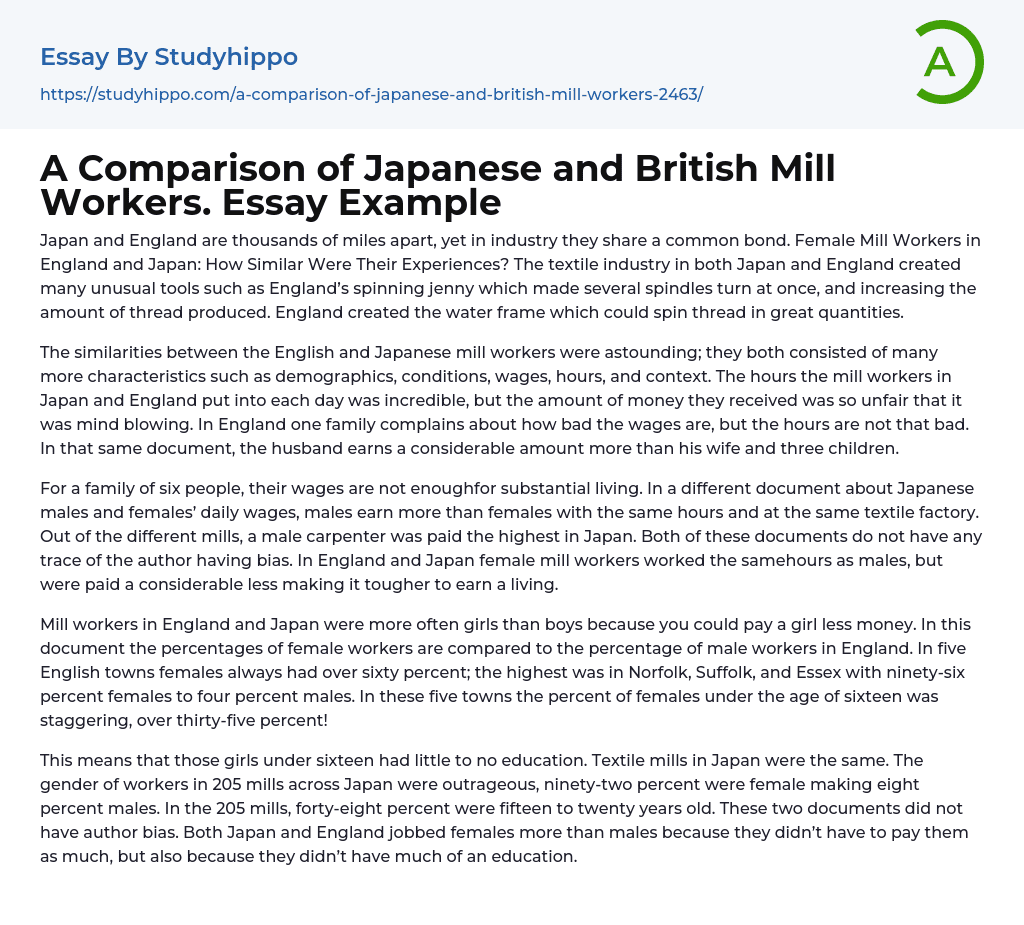

A Comparison of Japanese and British Mill Workers. Essay Example
Japan and England are thousands of miles apart, yet in industry they share a common bond. Female Mill Workers in England and Japan: How Similar Were Their Experiences? The textile industry in both Japan and England created many unusual tools such as England’s spinning jenny which made several spindles turn at once, and increasing the amount of thread produced. England created the water frame which could spin thread in great quantities.
The similarities between the English and Japanese mill workers were astounding; they both consisted of many more characteristics such as demographics, conditions, wages, hours, and context. The hours the mill workers in Japan and England put into each day was incredible, but the amount of money they received was so unfair that it was mind blowing. In England one family complai
...ns about how bad the wages are, but the hours are not that bad. In that same document, the husband earns a considerable amount more than his wife and three children.
For a family of six people, their wages are not enoughfor substantial living. In a different document about Japanese males and females’ daily wages, males earn more than females with the same hours and at the same textile factory. Out of the different mills, a male carpenter was paid the highest in Japan. Both of these documents do not have any trace of the author having bias. In England and Japan female mill workers worked the samehours as males, but were paid a considerable less making it tougher to earn a living.
Mill workers in England and Japan were more often girls than boys because you could pay a girl less money. In this document th
percentages of female workers are compared to the percentage of male workers in England. In five English towns females always had over sixty percent; the highest was in Norfolk, Suffolk, and Essex with ninety-six percent females to four percent males. In these five towns the percent of females under the age of sixteen was staggering, over thirty-five percent!
This means that those girls under sixteen had little to no education. Textile mills in Japan were the same. The gender of workers in 205 mills across Japan were outrageous, ninety-two percent were female making eight percent males. In the 205 mills, forty-eight percent were fifteen to twenty years old. These two documents did not have author bias. Both Japan and England jobbed females more than males because they didn’t have to pay them as much, but also because they didn’t have much of an education.
- Social Construction of Gender essays
- Feminism essays
- Animal Rights essays
- Animal Testing essays
- Bullying essays
- Abortion essays
- Abuse essays
- Immigration essays
- Poverty essays
- Human Rights essays
- Inequality essays
- Violence essays
- Torture essays
- Crash essays
- Assault essays
- Racism essays
- Prejudice essays
- Controversial Issue essays
- Cyber Bullying essays
- Women's Suffrage essays
- Women'S Rights essays
- Women Empowerment essays
- Sojourner Truth essays
- Bullying In Schools essays
- Pro Choice essays
- Pro Life essays
- Should Abortion Be Legal essays
- Against abortion essays
- Abortion Debate essays
- Abuse Support essays
- Child Abuse essays
- Alcohol Abuse essays
- Physical Abuse essays
- Sexual Abuse essays
- Substance Abuse essays
- Migration essays
- Human Migration essays
- Illegal Immigration essays
- Immigrants essays
- Refugee essays
- Overpopulation essays
- Homelessness essays
- Hunger essays
- Dumpster Diving essays
- Homelessness In America essays
- Euthanasia essays
- Assisted Suicide essays
- Censorship essays
- Gun Control essays
- Empowerment essays



